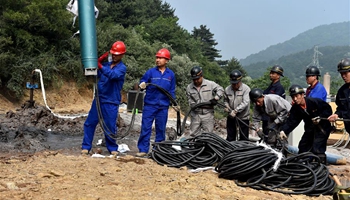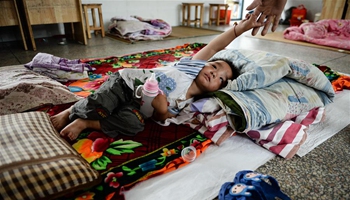WUHAN, July 6 (Xinhua) -- An overnight storm following days of rain has stopped traffic, cut power and water supplies and trapped people in their homes in many parts of Wuhan, a metropolis on the Yangtze River.
The downpour caused severe waterlogging as local rivers, lakes and reservoirs have swollen, leading to closure of a tunnel across the Yangtze as well as some subway stations and underground passages, according to local traffic authorities.
The capital city of central China's Hubei Province, Wuhan has about 10 million residents.
From 8 p.m. on Tuesday to 8 a.m. of Wednesday, precipitation in the city proper reached 180 millimeters, and the district of Caidian received 206 millimeters of rain.
Some 560 millimeters of rain fell on the city in the past week, the largest weekly precipitation since records began, according to the local meteorologic observatory. It forecast rain through Wednesday in Wuhan.
As of noon on Wednesday, floods have made 206 sections of road inaccessible to traffic and caused the suspension of 113 bus routes.
Twenty-three trains have been canceled and 30 delayed, according to the Wuhan Railway Bureau.
A Xinhua reporter saw water gush out of manhole covers and a section of road in Wuchang District inundated in two minutes, trapping cars in the water. He saw no public buses or taxis and failed to find a car through a taxi-hailing app on his way to the office in the morning.
More than 4,000 police officers and workers are pumping away flood waters, as well as ensuring the safety of pedestrians and vehicles.
Firefighters have rescued more than 100 people trapped by water. A pregnant woman, who was trapped on her way to delivery, was carried to a boat and escorted to hospital.
Over 16,000 people whose lives were threatened by fragile dikes were relocated from Caidian District to safety on Tuesday night.
Water supplies have been cut off in two residential communities, one of which also experienced a power blackout.
Companies and public institutions in some districts were ordered to adjust their working hours.
Provincial meteorological authorities said Nepartak, the first typhoon of the year, contributed to the torrential rain in Wuhan and other regions in the eastern part and Jianghan Plain of Hubei since Tuesday.
The areas saw decreased rainfall on Monday after being battered by downpours since June 30, while the typhoon, which is expected to bring gales and downpours to eastern coastal areas next week, pushed the center of the monsoon back to the areas on Tuesday.
Heavy rain since June 30 has left at least 48 people dead and seven unaccounted for in Hubei Province, the provincial Department of Civil Affairs said on Wednesday. About 525,000 people have been relocated. Around 21,000 houses have been destroyed and about 1.1 million hectares of farmland flooded, bringing direct economic losses about 18 billion yuan (about 2.69 billion U.S. dollars).
The rain has left at least 128 people dead with 42 missing across China, according to the Ministry of Civil Affairs on Tuesday.
Days of heavy rain raised water in the middle and lower reaches of the Yangtze River above warning levels.
The outflow water from the Three Gorges Reservoir into the river has been reduced since Wednesday, according to the Yangtze River Flood Control and Drought Relief Headquarters.
Affected by super El Nino, China is expected to continue face very complicated weather conditions, and there is a relatively high possibility of basin-wide floods this year, Vice Premier Wang Yang warned in mid-June.










